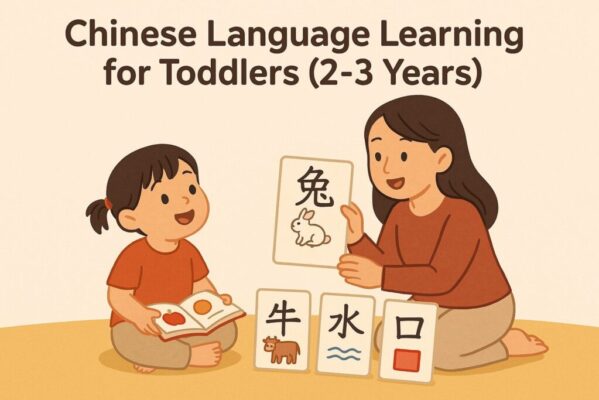Chinese Language Learning for Toddlers (2-3 Years)
The toddler years represent a remarkable window for language acquisition. At ages 2-3, children experience explosive growth in their language abilities, making it an ideal time to introduce a second language like Chinese. At GoEast Mandarin, we’ve witnessed countless toddlers absorb Chinese sounds, words, and cultural elements with a natural ease that often surprises their parents.
Understanding the Toddler Mind and Language Learning
Toddlers don’t “study” language—they acquire it naturally through meaningful interactions. At this age, children are in what linguists call a “critical period” for language development, where their brains are uniquely receptive to phonetic distinctions and grammatical patterns.
When teaching toddlers in our classrooms, we observe that they don’t approach Chinese as a foreign subject to be mastered, but rather as another fascinating dimension of their expanding world. This natural curiosity gives them an advantage that even the most dedicated adult learners can’t replicate.
What Makes Toddlers Unique Language Learners
The 2-3 year period stands apart from other developmental stages in several key ways:
- Sound recognition abilities: Toddlers can still distinguish between all speech sounds from any language, an ability that typically diminishes by age 5-6. When we introduce the four tones of Mandarin, toddlers often reproduce them with surprising accuracy.
- Lack of language inhibition: Unlike older children or adults, toddlers show no self-consciousness about attempting new sounds or words. In our classes, we notice they’ll happily attempt even challenging Chinese pronunciations without the hesitation older learners typically show.
- Neurological readiness: Research indicates that early bilingual exposure actually helps build more efficient brain networks. We’re not simply teaching language—we’re helping construct more robust neural architecture.
- Developmental appropriateness: Language learning at this age aligns perfectly with toddlers’ natural developmental tasks of categorizing their world and expanding communication.
Effective Chinese Learning Approaches for Toddlers
After years of teaching toddlers, we’ve refined approaches that work with—not against—their developmental needs:
Play-Based Chinese Learning
Structured play forms the cornerstone of effective toddler language teaching. When we introduce new Chinese vocabulary, we embed it in games that toddlers find intrinsically rewarding. For instance, simple hide-and-seek games where we count in Chinese or scavenger hunts where toddlers find colors or objects labeled in Chinese create natural language contexts.
Play isn’t just the sugar that helps the medicine go down—it’s actually how toddlers process and internalize new language concepts. When a toddler laughs while learning the Chinese word for “jump” (跳, tiào) while actually jumping, those neural connections form more strongly than they would through passive instruction.
Music and Movement Integration
Music bypasses the conscious learning process and speaks directly to the language acquisition centers of the brain. In our toddler classes, we use specialized Chinese songs with simple, repetitive lyrics paired with movements that represent the meaning.
One favorite is our “大和小” (dà hé xiǎo, big and small) song where toddlers stretch tall and crouch small while singing the corresponding words. Parents often report their children spontaneously singing these songs at home—evidence of deep language processing occurring naturally.
Storytelling and Chinese Language
Toddlers are beginning to follow simple narratives, making age-appropriate Chinese stories powerful teaching tools. We carefully select tales with repetitive phrases, clear imagery, and cultural relevance.
Rather than simply narrating, our teachers use exaggerated gestures, varied vocal tones, and visual props to make stories comprehensible even when the language isn’t fully understood. This “comprehensible input” approach allows toddlers to absorb language patterns while enjoying the story experience.
Sensory-Rich Environment
Young children learn through their senses, and our toddler Chinese classes purposefully engage multiple sensory channels. Children might trace simplified Chinese characters in sand trays, manipulate scented play dough while learning food vocabulary, or taste authentic Chinese snacks while learning related words.
This multi-sensory approach creates multiple pathways to memory and language retention. When a child learns “苹果” (píngguǒ, apple) while seeing, touching, smelling, and tasting an actual apple, that word becomes anchored in a rich sensory experience.
Realistic Expectations: What Toddlers Can Actually Learn
Parents sometimes approach us with either overly modest or unrealistically ambitious expectations. Based on our experience with hundreds of toddlers, here’s what you can realistically expect:
Receptive vs. Productive Language
Toddlers typically develop receptive Chinese skills (understanding) well before productive skills (speaking). Don’t be concerned if your 2-year-old seems to understand instructions in Chinese but doesn’t yet speak much. They’re absorbing the language patterns and will begin producing more Chinese as they become developmentally ready.
In our classes, we often see toddlers who appear to be simply enjoying activities suddenly use Chinese words or phrases weeks later, demonstrating that learning was occurring even when not immediately evident.
Vocabulary Development
By the end of a year of consistent exposure (either through classes or at home), many toddlers in our program develop a functional Chinese vocabulary of 50-100 words. These typically include:
- Family members (妈妈 māma, 爸爸 bàba)
- Common animals (狗 gǒu, 猫 māo)
- Basic colors (红 hóng, 蓝 lán)
- Everyday objects (杯子 bēizi, 书 shū)
- Simple action words (跳 tiào, 坐 zuò)
Pronunciation and Tones
Perhaps the most significant advantage toddlers have is in pronunciation. Many of our youngest students naturally acquire accurate tones and sounds that older learners struggle with for years. This phonological foundation will serve them throughout their Chinese learning journey.
Cultural Awareness
Beyond language, toddlers develop an initial framework for understanding Chinese culture. Through festival celebrations, traditional games, and culturally specific songs, they begin to understand that Chinese isn’t just a different way of speaking—it’s connected to different ways of doing things.
Supporting Your Toddler’s Chinese Learning at Home
The most successful toddlers in our program have parents who support Chinese learning between classes. Here are practical strategies we recommend:
Creating Language Moments, Not Lessons
Formal study sessions are inappropriate for toddlers. Instead, create brief, natural “language moments” throughout your day. Label items in Chinese during meals, count stairs as you climb them, or name body parts during bath time.
These micro-interactions only take seconds but accumulate meaningfully over time. One parent in our program simply began saying “再见” (zàijiàn, goodbye) consistently when leaving rooms, and her toddler naturally began using it appropriately within weeks.
Technology: Friend or Foe?
While we generally advocate for human interaction, select Chinese apps and videos can supplement learning when used judiciously. Look for programs with:
- Native speaker models
- Simple, relevant vocabulary
- Engaging but not overstimulating visuals
- Interactive elements rather than passive watching
We recommend limiting screen time to 15-20 minutes per session, and whenever possible, watch together rather than using technology as a babysitter.
Family Involvement Without Fluency
Even parents who don’t speak Chinese can support learning. Try:
- Learning basic phrases alongside your child
- Asking your child to “teach” you words they know
- Showing genuine interest in what they’re learning
- Creating consistent contexts for Chinese use (perhaps Chinese is always used at dinner time or bath time)
Parents who model language learning as a joyful activity, rather than a chore, tend to have children who develop the same attitude.
Common Challenges and Solutions
In our years of teaching toddlers, we’ve encountered several recurring challenges:
Attention Span Limitations
Challenge: Toddlers typically maintain focused attention for only 5-10 minutes.
Solution: We structure our classes as a series of short, varied activities rather than extended lessons. At home, follow your child’s interest level and switch activities before boredom sets in.
Mixed Heritage Considerations
Challenge: For mixed families, balancing Chinese with other languages can seem overwhelming.
Solution: Establish clear language boundaries—perhaps one parent speaks Chinese, or Chinese is used during specific activities. Consistency in these boundaries helps toddlers navigate multiple language environments.
Separation Anxiety
Challenge: Many toddlers experience separation anxiety in classroom settings.
Solution: Our progressive separation approach allows parents to remain in class initially, then gradually step back as children become comfortable. This transition typically takes 2-3 weeks for most toddlers.
Pronunciation Support for Non-Chinese Speaking Parents
Challenge: Parents who don’t speak Chinese worry about reinforcing incorrect pronunciation.
Solution: We provide parents with audio recordings of vocabulary and phrases used in class. Additionally, focusing on listening activities at home can be valuable even without speaking practice.
The GoEast Approach to Toddler Chinese Learning
Our toddler program has evolved through years of classroom experience and continual refinement. A few distinctive elements include:
Thematic Learning Cycles
Rather than isolated lessons, we organize learning around two-week thematic cycles that allow for natural vocabulary repetition and expansion. A theme like “Animals” might begin with basic animal names, then expand to habitats, movements, and sounds.
Parent-Child Connection
Unlike some programs that separate children and parents, we view parents as essential partners. Our classes include take-home activities specifically designed to extend learning naturally at home.
Developmental Alignment
Our curriculum specialists align Chinese learning objectives with overall developmental milestones. For instance, as toddlers develop categorization skills, we introduce Chinese vocabulary that helps them organize their world (big/small, colors, shapes).
Consistent Teacher Relationships
Toddlers thrive on consistency and attachment. Unlike programs with rotating teachers, we ensure each class has a consistent primary teacher who builds a relationship with each child, creating the emotional safety needed for language risk-taking.
Beginning the Chinese Learning Journey
Starting Chinese during the toddler years isn’t just about giving your child an academic advantage—it’s about opening a window to another way of thinking, communicating, and experiencing the world.
The language foundations built during these formative years—whether in pronunciation, vocabulary, or simply comfort with different sounds—will serve your child throughout their learning journey. Perhaps more importantly, early positive experiences with Chinese help develop an open, curious mindset about language and cultural differences.
Whether your toddler eventually becomes fully bilingual or simply develops an appreciation for Chinese language and culture, the early exposure during these receptive years plants seeds that will continue to grow in unexpected and rewarding ways.
If you’re considering Chinese classes for your toddler, we invite you to observe one of our classes and experience our approach firsthand. The joy of watching young children embrace a new language is something that never gets old—even for teachers who have witnessed it hundreds of times.






